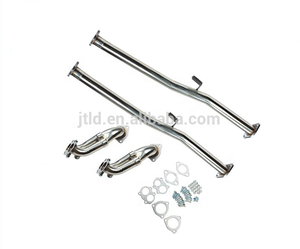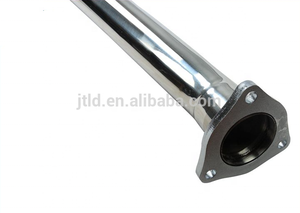Phổ biến trong ngành của bạn






Giá rẻ chất lượng cao hệ thống ống xả điều khiển từ xa cho Lexus IS250/300 2006 2013 2.5L Muffler ống xả catback
600,00 US$ - 699,00 US$
Đơn hàng tối thiểu: 1 Cái
Vận chuyển mỗi chiếc: 132,32 US$







Chất lượng tốt nhất hệ thống ống xả điều khiển từ xa cho lexus is250/300 2006-2013 2.5l muffler ống xả catback
600,00 US$ - 699,00 US$
Đơn hàng tối thiểu: 1 Cái
Vận chuyển mỗi chiếc: 132,32 US$







Tùy chỉnh Hợp kim Titan catback xả cho Nissan GTR R34 R35 xả Muffler xe xả
1.098,00 US$ - 1.498,00 US$
Đơn hàng tối thiểu: 1 Bộ







Trực tiếp phù hợp với autoparts nhà máy xả Muffler cho Aveo buồm xả muffler
13,90 US$ - 16,90 US$
Đơn hàng tối thiểu: 10 Cái
Vận chuyển mỗi chiếc: 892,67 US$







Skyley không hàn xỉ Infiniti G37 xả catback cho Infiniti G37 xả catback
645,00 US$ - 690,00 US$
Đơn hàng tối thiểu: 1 Bộ







Thanh Treo Thanh Titan Cho Toyota Supra JZA80 MK IV TRB Kiểu Ống Xả Titan
450,00 US$
Đơn hàng tối thiểu: 2 Bộ




Ống Xả Đánh Bóng Gương Bằng Thép Không Gỉ 304 Cho Ống Góp Turbo 90-96 300ZX Z32 Non Turbo
41,90 US$ - 101,00 US$
Đơn hàng tối thiểu: 10 Cái





90-96 300zx catback xả cho Nissan
Sẵn sàng vận chuyển
245,00 US$
Đơn hàng tối thiểu: 20 Bộ
Vận chuyển mỗi chiếc: 87,81 US$






Ống Xả SS201 Giá Tốt Chất Lượng Hàng Đầu Trung Quốc Có Sẵn Cho N Issan 300zx Z32 VG30DETT 90-96
Sẵn sàng vận chuyển
48,00 US$ - 58,00 US$
Đơn hàng tối thiểu: 1 Cái
Vận chuyển mỗi chiếc: 43,89 US$






Thép không gỉ xả downpipe phù hợp cho Nissan 90-96 300zx Turbo 3.0L Fairlady Z32 vg30dett xuống ống xả
75,40 US$
Đơn hàng tối thiểu: 30 Bộ
Vận chuyển mỗi chiếc: 33,78 US$




Cao Chất Lượng Thép Không Gỉ Downpipe xả Tuabin Chất Lượng Cao phù hợp cho Nissan 90-96 300ZX Turbo 3.0L Fairlady Z32 VG30DETT
185,00 US$ - 280,00 US$
Đơn hàng tối thiểu: 10 Bộ
Vận chuyển mỗi chiếc: 94,25 US$



Ống xả Tiêu Đề cho NI SSAN 300ZX Z32 3L V6 Không Turbo
45,00 US$ - 65,00 US$
Đơn hàng tối thiểu: 30 Bộ

300ZX Z32 VG30DETT Thép Không Gỉ Downpipe Xả Twin Turbo Cho Nissan 90-96
35,00 US$ - 55,00 US$
Đơn hàng tối thiểu: 20 Cái






Epman không dây có thể điều chỉnh điều khiển từ xa dây nịt Muffler Van điều khiển hệ thống ống xả điện EP-CUT001A-DZ
Sẵn sàng vận chuyển
26,47 US$ - 27,60 US$
Đơn hàng tối thiểu: 10 Cái
Vận chuyển mỗi chiếc: 8,33 US$

Động Cơ Các Bộ Phận Tuabin Thép Không Gỉ Downpipe Ống Xả Cho Nissan 300ZX Z32 VG30DETT 90-96
29,00 US$ - 79,00 US$
Đơn hàng tối thiểu: 50 Cái

Lớp Phủ Gốm Xả Ống Xả Exhaust Manifold Tiêu Đề Downpipe Cho Nissan 300zx Z32 VG30DETT 90-96
50,00 US$ - 100,00 US$
Đơn hàng tối thiểu: 1 Bộ






Giá Cả Tốt Đẹp Giá Cả Phải Chăng Hiệu Suất Hệ Thống Ống Xả Ống Xả Cho Nissan 300ZX Z32
40,00 US$ - 150,00 US$
Đơn hàng tối thiểu: 30 Cái

Cho Nissan 300ZX Z32 2 Ghế Turbo & Non-Turbo 3.0L 90-96 Catback Không Gỉ 201 SS304 Xả hệ Thống
800,00 US$ - 1.900,00 US$
Đơn hàng tối thiểu: 20 Bộ

Ống xả 03-10 cho Ford 6.0L powerstroke hệ thống ống xả động cơ diesel y-pipe
120,00 US$ - 125,00 US$
Đơn hàng tối thiểu: 30 Cái
Vận chuyển mỗi chiếc: 208,70 US$






Kiểm tra Ống SS phù hợp với cho Nis * san 300ZX Z32 90-96 Fairlady VG30DETT TWINTURBO MÔ HÌNH
Sẵn sàng vận chuyển
52,50 US$
Đơn hàng tối thiểu: 4 Đơn vị
Vận chuyển mỗi chiếc: 26,58 US$

20630 g1001 xả móc áo một 12 phù hợp cho động cơ cao su Nissan gắn kết miếng đệm & treo gắn Chất lượng cao
0,10 US$ - 0,50 US$
Đơn hàng tối thiểu: 200 Cái






New phụ tùng ô tô 6-pins 12V xe tiếp sức phù hợp với 25230-c9970 cho Nissan 240sx 300zx altima Pickup Infiniti
0,80 US$ - 1,50 US$
Đơn hàng tối thiểu: 10 Cái






Bộ Ống Xả Ống Xả Xe Đua Tur-Bo Bằng Thép Không Gỉ Cho NIS-SAN 1990-1996 300ZX 3.0L
73,00 US$ - 77,00 US$
Đơn hàng tối thiểu: 10 Bộ






Thép không gỉ xả downpipe phù hợp cho Nissan 90-96 300zx Turbo 3.0L Fairlady Z32 vg30dett xuống ống cho xe ô tô
88,70 US$ - 102,50 US$
Đơn hàng tối thiểu: 30 Bộ
Vận chuyển mỗi chiếc: 36,76 US$





Linh Kiện Xe Tải Bán Sỉ Nhà Máy Ống Xả/Ống Xả Xe Tải Chất Lượng Cao
Sẵn sàng vận chuyển
4,85 US$ - 5,00 US$
Đơn hàng tối thiểu: 50 Cái
Vận chuyển mỗi chiếc: 5,18 US$






Động cơ intake Hơi Ống Hose 16576-et00a tự động truyền lắp ráp cho Nissan Sentra
6,00 US$ - 8,00 US$
Đơn hàng tối thiểu: 4 Cái
Vận chuyển mỗi chiếc: 4,79 US$






JIAJUN Cutout Valvetronic Hệ Thống Downpipe Catback RS3 8V TTRS 8S Cho Audi Xả
325,00 US$
Đơn hàng tối thiểu: 10 Bộ


Ông srainless Ống Xả Bằng Thép Tiêu Đề cho 90-96 NI SSAN 300ZX Z32 3L V6 Không Turbo Ống Xả
45,00 US$ - 65,00 US$
Đơn hàng tối thiểu: 30 Bộ



Hiệu Suất Tự Động Một Phần Xả Manifold Tiêu Đề Cho 90-96 Nissan 300ZX Z32 Turbo Bộ Phận Động Cơ
49,00 US$ - 199,00 US$
Đơn hàng tối thiểu: 50 Cái




Ceramic coating stainless exhaust pipes exhaust muffler manifold exhaust headers for nissan 90-96 300ZX Z32 Non Turbo
50,00 US$ - 150,00 US$
Đơn hàng tối thiểu: 1 Bộ






Thép không gỉ 1.5 ", 1.75" 2 ", 2.25", 2.5 ", 2.75", 3 ", 3.5", 4 "hàn dài bán kính 90 khuỷu tay cho xe sửa đổi Ống xả khuỷu tay
Sẵn sàng vận chuyển
1,50 US$ - 6,00 US$
Đơn hàng tối thiểu: 10 Cái
Vận chuyển mỗi chiếc: 3,71 US$

Ống xả đa dạng cho Nissan vg30de không Turbo 300zx Z32 90-96 tiêu đề tay trái ổ đĩa LHD xe
100,00 US$ - 120,00 US$
Đơn hàng tối thiểu: 30 Cái
Vận chuyển mỗi chiếc: 231,89 US$

Thương hiệu Mới Thép không gỉ xả downpipe 300zx Z32 vg30dett 90-96
8,00 US$ - 12,00 US$
Đơn hàng tối thiểu: 20 Cái





Thích hợp cho Nissan 300zx Z32 2 chỗ tăng áp và không tăng áp 3.0L 90-96 hiệu suất hệ thống ống xả ngược
200,00 US$
Đơn hàng tối thiểu: 50 Bộ






Giá Cả Tốt Đẹp Giá Cả Phải Chăng Hiệu Suất Hệ Thống Ống Xả Ống Xả Cho Nissan 300ZX 3.0L
40,00 US$ - 150,00 US$
Đơn hàng tối thiểu: 30 Cái




Hệ Thống Phụ Tùng Ô Tô Bằng Inox Ống Xả N Issan 300zx Z32 VG30DETT 90-96
Sẵn sàng vận chuyển
47,00 US$ - 55,00 US$
Đơn hàng tối thiểu: 20 Cái
Vận chuyển mỗi chiếc: 15,61 US$

20630 p4400 xả móc áo SD 22 phù hợp cho động cơ cao su Nissan gắn kết miếng đệm & treo gắn Chất lượng cao
0,10 US$ - 0,50 US$
Đơn hàng tối thiểu: 200 Cái





Hiệu Suất Cao Titan Xả Cho Honda S2000 AP1 AP2 3 Inch Ống Dianmeter
699,00 US$ - 799,00 US$
Đơn hàng tối thiểu: 2 Cái
Các danh mục hàng đầu
Giới thiệu về nissan 300zx xả
Alibaba.com có một bộ sưu tập toàn diện về chất lượng cao, độ bền và tình trạng mới nissan 300zx xả. sản phẩm và nguồn cung cấp cho khách hàng để lấy với giá cả phải chăng nhất. Toàn bộ bộ sưu tập các sản phẩm được cung cấp trên trang web là các sản phẩm đã qua sử dụng trong tình trạng nguyên sơ và việc mua chúng hoàn toàn xứng đáng từng xu. Cho dù ai đó muốn mua xe cộ, đồ điện tử và thậm chí cả đồ uống cứng như rượu whisky, sâm panh, người ta có thể tìm thấy tất cả các loại sản phẩm trên trang web với các giao dịch cạnh tranh. Những nissan 300zx xả này. nguồn cung cấp và sản phẩm được kiểm tra cẩn thận để có chất lượng hoàn hảo và tất cả đều ở trong điều kiện hoạt động hoàn hảo.
Bộ sưu tập đa dạng của loại cao cấp nissan 300zx xả. các sản phẩm có sẵn trên trang web được nhập khẩu từ nhiều nơi khác nhau trên toàn cầu và được kiểm tra bởi các kỹ thuật viên chuyên nghiệp. Những sản phẩm này bao gồm các sản phẩm đã qua sử dụng hoặc đồ cũ được bán với giá tiết kiệm. Người ta cũng có thể lấy các thiết bị, sản phẩm và phương tiện cao cấp, chọn từ nhiều loại sản phẩm có thể truy cập trên trang web. Nhiều sản phẩm trong số này đi kèm với sự đảm bảo của nhà cung cấp và thương mại và có thể tuân theo các điều khoản và điều kiện của người bán.
Tại Alibaba.com, các danh mục riêng biệt của nissan 300zx xả. vật tư và sản phẩm được kiểm tra cẩn thận để đảm bảo phần cứng bên trong trong trường hợp thiết bị điện tử và xe ở tình trạng tốt nhất. Trong trường hợp đồ uống như rượu whisky lưu niệm và đồ uống khác, chất lượng và thời hạn sử dụng của sản phẩm được kiểm tra kỹ lưỡng. Đối với ô tô, chất lượng động cơ, bánh răng an toàn và điều kiện lái xe được kiểm tra nghiêm ngặt để tránh sai sót. Người ta cũng có thể chọn những chiếc đồng hồ sang trọng trong tình trạng tốt nhất và mang lại giá trị tốt nhất cho đồng tiền.
Xem nhiều đồng hồ nissan 300zx xả. phạm vi trên Alibaba.com và mua những sản phẩm này trong phạm vi ngân sách và khả năng chi trả. Những sản phẩm này dành cho mục đích sử dụng dành cho giới tính, và người ta cũng có thể tìm thấy các sản phẩm cho đồ trang trí nội thất, trẻ em và nhiều sản phẩm khác. Sản phẩm cũng được làm sạch, tráng và bảo dưỡng trước khi bán.
Bộ sưu tập đa dạng của loại cao cấp nissan 300zx xả. các sản phẩm có sẵn trên trang web được nhập khẩu từ nhiều nơi khác nhau trên toàn cầu và được kiểm tra bởi các kỹ thuật viên chuyên nghiệp. Những sản phẩm này bao gồm các sản phẩm đã qua sử dụng hoặc đồ cũ được bán với giá tiết kiệm. Người ta cũng có thể lấy các thiết bị, sản phẩm và phương tiện cao cấp, chọn từ nhiều loại sản phẩm có thể truy cập trên trang web. Nhiều sản phẩm trong số này đi kèm với sự đảm bảo của nhà cung cấp và thương mại và có thể tuân theo các điều khoản và điều kiện của người bán.
Tại Alibaba.com, các danh mục riêng biệt của nissan 300zx xả. vật tư và sản phẩm được kiểm tra cẩn thận để đảm bảo phần cứng bên trong trong trường hợp thiết bị điện tử và xe ở tình trạng tốt nhất. Trong trường hợp đồ uống như rượu whisky lưu niệm và đồ uống khác, chất lượng và thời hạn sử dụng của sản phẩm được kiểm tra kỹ lưỡng. Đối với ô tô, chất lượng động cơ, bánh răng an toàn và điều kiện lái xe được kiểm tra nghiêm ngặt để tránh sai sót. Người ta cũng có thể chọn những chiếc đồng hồ sang trọng trong tình trạng tốt nhất và mang lại giá trị tốt nhất cho đồng tiền.
Xem nhiều đồng hồ nissan 300zx xả. phạm vi trên Alibaba.com và mua những sản phẩm này trong phạm vi ngân sách và khả năng chi trả. Những sản phẩm này dành cho mục đích sử dụng dành cho giới tính, và người ta cũng có thể tìm thấy các sản phẩm cho đồ trang trí nội thất, trẻ em và nhiều sản phẩm khác. Sản phẩm cũng được làm sạch, tráng và bảo dưỡng trước khi bán.




















